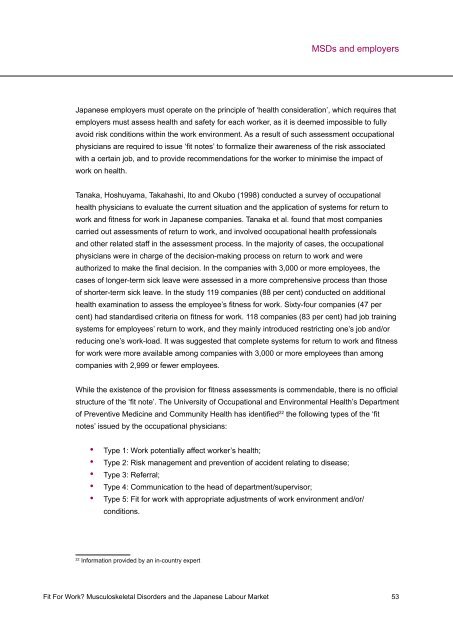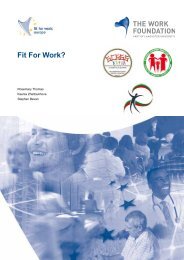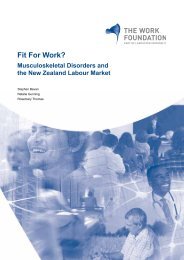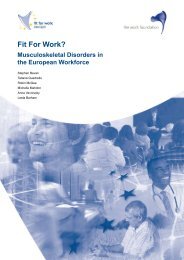English version - Fit for Work Europe
English version - Fit for Work Europe
English version - Fit for Work Europe
Create successful ePaper yourself
Turn your PDF publications into a flip-book with our unique Google optimized e-Paper software.
Japanese employers must operate on the principle of ‘health consideration’, which requires that<br />
employers must assess health and safety <strong>for</strong> each worker, as it is deemed impossible to fully<br />
avoid risk conditions within the work environment. As a result of such assessment occupational<br />
physicians are required to issue ‘fit notes’ to <strong>for</strong>malize their awareness of the risk associated<br />
with a certain job, and to provide recommendations <strong>for</strong> the worker to minimise the impact of<br />
work on health.<br />
Tanaka, Hoshuyama, Takahashi, Ito and Okubo (1998) conducted a survey of occupational<br />
health physicians to evaluate the current situation and the application of systems <strong>for</strong> return to<br />
work and fitness <strong>for</strong> work in Japanese companies. Tanaka et al. found that most companies<br />
carried out assessments of return to work, and involved occupational health professionals<br />
and other related staff in the assessment process. In the majority of cases, the occupational<br />
physicians were in charge of the decision-making process on return to work and were<br />
authorized to make the final decision. In the companies with 3,000 or more employees, the<br />
cases of longer-term sick leave were assessed in a more comprehensive process than those<br />
of shorter-term sick leave. In the study 119 companies (88 per cent) conducted on additional<br />
health examination to assess the employee’s fitness <strong>for</strong> work. Sixty-four companies (47 per<br />
cent) had standardised criteria on fitness <strong>for</strong> work. 118 companies (83 per cent) had job training<br />
systems <strong>for</strong> employees’ return to work, and they mainly introduced restricting one’s job and/or<br />
reducing one’s work-load. It was suggested that complete systems <strong>for</strong> return to work and fitness<br />
<strong>for</strong> work were more available among companies with 3,000 or more employees than among<br />
companies with 2,999 or fewer employees.<br />
While the existence of the provision <strong>for</strong> fitness assessments is commendable, there is no official<br />
structure of the ‘fit note’. The University of Occupational and Environmental Health’s Department<br />
of Preventive Medicine and Community Health has identified22 the following types of the ‘fit<br />
notes’ issued by the occupational physicians:<br />
• Type 1: <strong>Work</strong> potentially affect worker’s health;<br />
• Type 2: Risk management and prevention of accident relating to disease;<br />
• Type 3: Referral;<br />
• Type 4: Communication to the head of department/supervisor;<br />
• Type 5: <strong>Fit</strong> <strong>for</strong> work with appropriate adjustments of work environment and/or/<br />
conditions.<br />
22 In<strong>for</strong>mation provided by an in-country expert<br />
MSDs and employers<br />
<strong>Fit</strong> For <strong>Work</strong>? Musculoskeletal Disorders and the Japanese Labour Market 53







